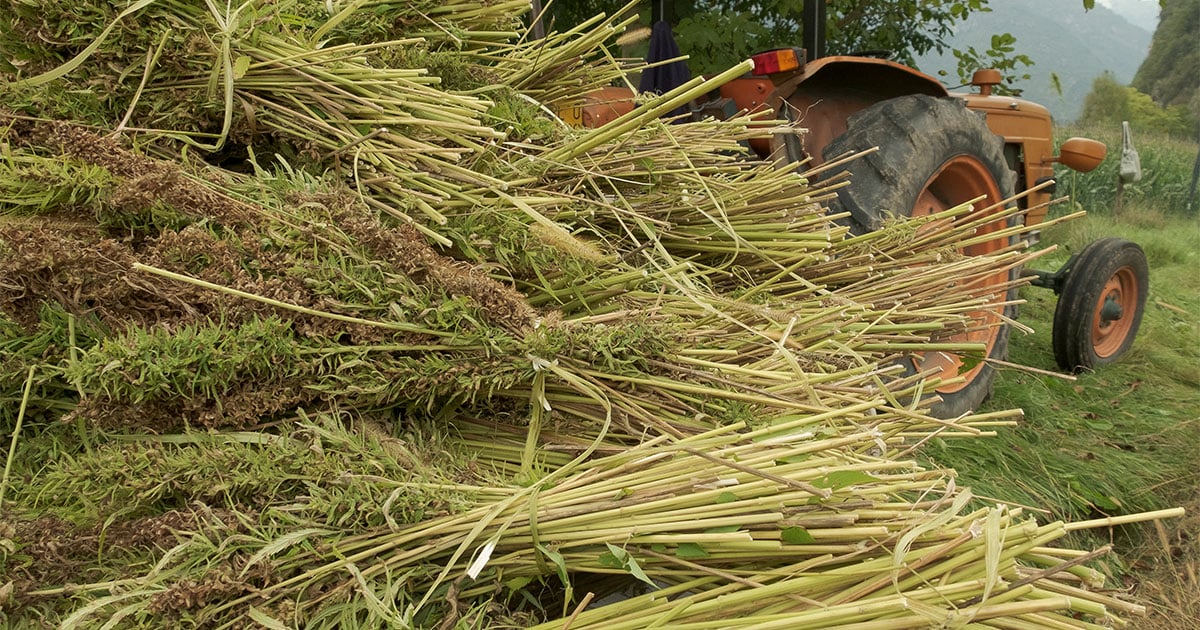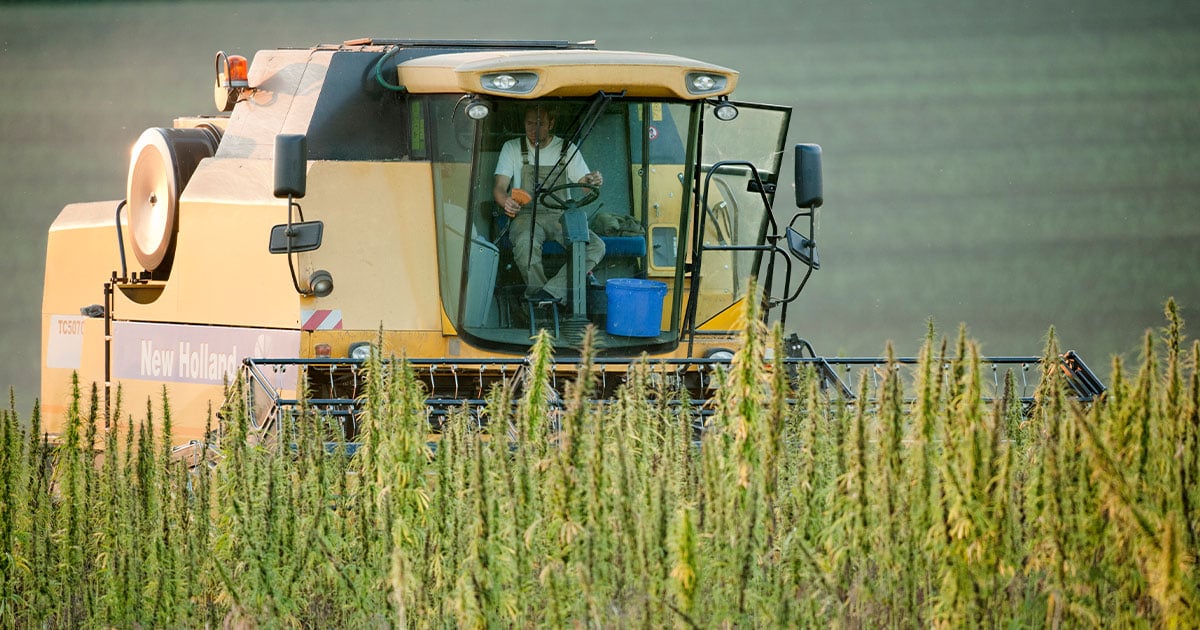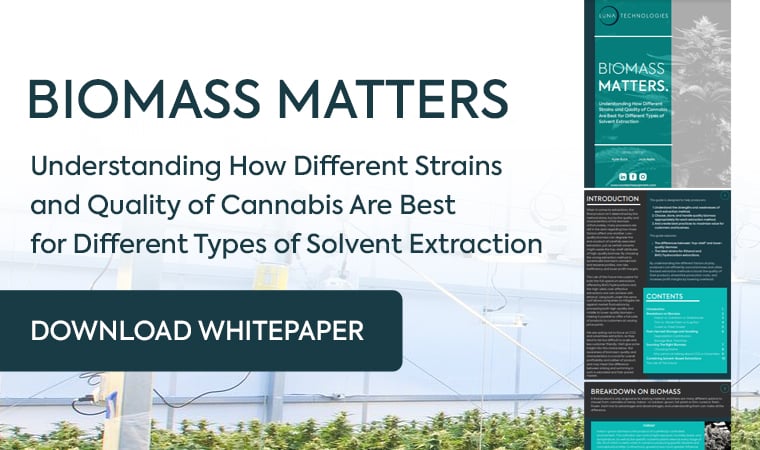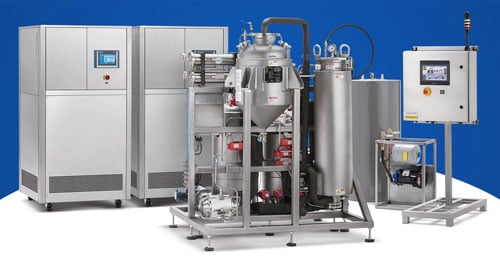Hemp harvests are finally seeing their time in the sun. From its inner hurd to its CBD-rich flowers, hemp serves several industrial and therapeutic purposes. Hemp's legalization has particularly allowed the market to catch up with demand.
In light of hemp biomass' rising popularity, its cultivation has become the backbone of the industry. After months of carefully tending to your crop, it is time to consider optimizing your harvesting techniques. If you want to give customers and processors the highest quality biomass, consider our step-by-step guide on nailing the landing.
What Is Hemp Biomass?
First, let's break down the nomenclature of raw hemp material. Hemp biomass refers to the plant material such as the flowers, leaves, and stalks. After harvesting your bountiful flowers, you are left with valuable organic material with only trace amounts of CBD.
At first glance, this undesirable plant material may be classified as waste. However, hemp biomass has a number of different industrial uses, if treated and dried correctly. Hemp growers can use biomass in the production of concentrates, for its leaves, and as a biofuel.
In addition, leftover hemp from your harvest can be an excellent starting material in the production of fiber, cord, and cloth. In this case, a retting technique breaks down the fibrous strands of the plant's stalk to streamline the processing that occurs after.
Every part of the hemp plant has an end use from its seeds to its stalks. If you are looking to get the most out of your hemp crop, the harvesting phase is a crucial step that shouldn't be overlooked. Here is a complete guide on harvesting your hemp biomass.
Harvesting Tools
Harvesting hemp for CBD or fiber biomass both involve similar techniques with minor but important considerations for each.

Equipment
For both processes, you are going to need the following tools/equipment:
- Cutting tool (machete, shears, scythe)
- Transportation vehicle (tractor, trailer, truck)
- Storage facility (barn, shed, lab)
While the initial harvesting phase may be the same when harvesting CBD flower or hemp fiber biomass, the process differs significantly in the end when they're getting ready for processing. For instance, harvesting hemp for oils or biofuel requires a unique drying and extraction process. Harvesting for hemp fiber, on the other hand, requires a retting process and a decorticator to extract the fiber for industrial uses.
Labor
While not exactly a tool, your labor requirements affect the speed and quality of your harvest. If you are short-staffed, your harvesting times can be extended and cause you to miss the peak harvest time. For every 5 to 6 acres, you'll need about 15 workers to harvest your crop.
How and When to Harvest Hemp
Knowing when to harvest starts way before you plant your seeds in the ground. Estimating your plant's life cycle can help you give your plants the right lights, nutrients, and medium to grow huge yields. If you harvest too early, you'll end up with biomass that hasn't reached its peak maturity and resin level. If you harvest too late, your flowers can begin to age and lose potency.
In a small operation, harvesting below your peak potential won't cause too much profit loss. However, if you are harvesting a large volume of hemp, you need to get the harvest timing right. In large batches, even a 1% difference in CBD or CBG results in a considerable loss of CBD oil. In the end, you could lose thousands of dollars due to improper harvesting practices.
Another important consideration when harvesting hemp, is the level of THC in your hemp crop. As your plant matures, its THC content goes up significantly. As part of the 2018 Farm Bill, farmers must grow plants that are below the 0.3% THC threshold. If your hemp plants go considerably above this limit, you'll be forced to dispose of your crop and lose out on time and money.
Back in the day, you could get away with visually inspecting your crop to figure out the best time to harvest hemp by looking at your hemp plant's trichomes. Beginning their life as clear mushroom-like resin glands, over time, the trichomes mature and turn a milky white color. When they're white, it is the right time to harvest.
Today, federal hemp regulations require growers to test their hemp to remain below the THC threshold. In order to remain compliant, hemp farmers are recommended to regularly test their plants for potency, mildew, pests, and other contaminants. While testing can be expensive, it'll help you stay compliant and determine the best CBD and CBG levels. In some states, lab testing before a hemp harvest is required. Stay informed about your state and local regulations to have a successful hemp harvest.
Hemp Biomass: A Step-by-Step Guide to Harvesting Hemp
From the moment you plant your hemp crop, expect it to fully mature in 100 to 120 days. Some fast-growing crops can be ready in as little as 90 days. In addition, auto-flowering hemp varieties can be ready for harvest in about 75 days, allowing farmers to harvest multiple times throughout the year.
In The US, Canada, and other North American farms, farmers harvest their hemp in late summer and early fall. When the days get shorter your hemp plants will begin to flower until they reach their peak ripeness and are ready to be harvested.
Cutting during the early fall allows you to avoid dealing with seasonal disruptions such as hurricanes on the East Coast and wildfires on the West. For this reason, knowing when to harvest your hemp determines the quality of your crop.
When handling the harvesting season, the equipment and team you have will determine how fast and effective you have harvested your hemp. Small-batch operators can get away with a handful of helpers and cutting down each hemp plant by hand.
Commercial and large-scale industrial hemp farms will require a hefty investment in equipment and labor to speed up the harvesting stage. With the extra equipment and acres to handle, you'll need a larger team to pick up the workload.
If you are just getting into the rhythm of the market, a good starting point is growing up to 1 acre on your first try. Starting with this manageable farm size gives you a low-risk way to solidify standard operating procedures and determine the right time to harvest. Starting off with an acre or less requires two people at most.
If you are planning on growing at least 2 acres and under 4 acres, you'll need up to 4 helpers to help you harvest hemp. Harvesting this crop size also allows you to begin a crop rotation cycle where part of the farm grows your hemp while the other part improves the soil's health using cover crops such as legumes and grasses such as oats.

For farms over 5 acres, investing in a combine requires a significant initial upfront investment and maintenance costs. Despite its price, it pays for itself over time by cutting down the harvesting time significantly. If you'll be investing in a combine, consider the operator skill level.
If using a combine, you must also consider the environmental conditions before cutting down your hemp plants. Ideally, you want humidity levels to be 50% or below, temperatures to be between 65 and 90º F, and at most a light wind.
Check the weather reports beforehand to make sure you won't get rained in or experience heavy winds. Working in a dry climate allows the hemp to dry properly before being processed. A heavy rainfall can damage hemp, remove terpenes, and add extra time to the drying and curing process.
Finally, when harvesting hemp, make sure to cut 2 to 3 cm from the soil with your cutting tool. Farmers can place their plants on a method of transportation on top of each other and move on to the final stage of harvesting.
Drying and Curing
After you harvested and transported your hemp plants to a drying location, you can prepare to dry your hemp harvest. Some farmers choose to skip the drying and curing and send it right to the processor. Drying hemp can be performed in a number of locations from state-approved facilities to a farmhouse. Above all, you must have enough space and proper airflow to speed up the drying process.
Throughout the plant's life cycle, moisture accumulates in the buds, leaves, and stalks. When it is time to harvest hemp, a big part of that means drying out the excess moisture to allow the CBD and terpenes to shine. If left unchecked, the abundance of moisture is the perfect breeding ground for mold and mildew. Mold and mildew formation can effectively destroy the quality of your harvest.
When you have your plants ready for the drying process, begin by cutting each branch from your plant and hanging them up one by one. Separating the branches allows for a speedier drying process and prevents the contamination of your flowers. Some growers dry their hemp on screens. For this method, cut your hemp branches into small sections to fit within your screen surface.
Most growers hang their hemp branches from a drying wire, hanger, or clamp. Each method allows you to hang your branches separately and give them the right amount of air flow using a fan for 3 to 5 days. Of course, drying times vary by crop size, airflow, and temperature. Drying can take longer than the standard time.
Drying temperature should be between 60 and 70º F with a humidity of 60%. Investing in a temperature control system with dehumidifying capabilities can optimize the drying and curing stage to prevent mold and mildew.
The drying stage is complete when the hemp plants are below 15% moisture or 12%, ideally. Hemp biomass dries much quicker than hemp flowers. Biomass can dry in a few days while flowers can take up to 10 days.
Nowadays, hemp processors expect farmers to cure their hemp products. Curing keeps hemp flowers in an airtight container to reduce even more moisture. Curing can take an additional few weeks but can help bring out the flavor and aroma of the hemp flowers.
All the while, perform a potency and purity test to determine its CBD and CBG content. The test should also indicate your hemp's THC levels. Finally, quality testing looks for contaminants that may hurt your harvest.
Retting Hemp Biomass
If you'll be harvesting hemp for its fibers, retting allows you to break down the fibers of the stalk using microorganisms and moisture. The combination of the two begins a process where the fibers are separated from the stalk.
Water Retting
Most farmers stick with water retting, which essentially requires you to soak your stalks in water. Once soaked, the cellular membrane becomes swollen, which makes the separation process much easier.
Natural water retting has a long history in agriculture. With this method, you simply have to dunk your hemp stalks in a naturally-occurring water source such as a lake, pond, river, or stream. It helps if you tie together a bundle of stalks and place a weight on them to keep them from floating back up. Natural water retting can take anywhere between 1 to 2 weeks depending on the water's mineral content.
In tank retting, the process is performed in a more controlled environment. In about half the time, the mineral dense water speeds up the process. Once you are done, the mineral dense water can act as a liquid fertilizer for your crops. Keep in mind, any harmful chemicals used during cultivation can end up in the mineral dense water. You may need to filter them out before feeding it to your soil.
After you completed the retting process, you must dry out your stalks for between 1 to 3 days before you start the curing process.
Dew Retting
If water sources aren't near or you don't have the capacity for a tank, dew retting is a popular alternative. First, you must cut down your hemp and leave them on the ground in rows so that each stalk gets plenty of air flow. At night, the moisture penetrates the stock while the day's warm sunlight provides the perfect breeding ground for bacteria.
This bacterial growth provides an effective way to breakdown the biomass and allow for easy separation. However, water retting can take considerably longer, between 2 to 4 weeks. In addition, the quality of the biomass derived from dew retting can be lower than any other method.
Hemp Biomass Storage

Once you have prepared your hemp biomass, it is time to think about the best place to store it.
For small hemp cultivation sites, dried hemp can be stored in a number of places. Use anything from flexible fabric bags to plastic bins or cotton/hemp sacks. Once properly stored in a container, you can keep them in a low-moisture room.
For larger hemp cultivation sites that require a combine, after using your combine to cut up your large crop, you'll need to leave that hemp out for a few days to dry. To speed up the drying process, rake your plants with a hay rake or tedder to arrange your plants in rows.
After drying, the dry hemp will be baled using an automatic baler and tractor. Any hay baler will do. Take your pick of square or round bales depending on where you need to store your biomass. Above all, try to keep a low moisture content for each bale, ideally 15% or less.
The tightly squeezed bale can create excessive moisture if the plants are too wet. In this instance, bacteria can form ruining your biomass or worse, start a fire. Hay bales aren't the only bales that can spontaneously combust under the wrong conditions.
Believe it or not, wet hemp bales are more combustible than dry ones. When internal temperatures (between 125 and 130º F) of the hemp rise above a certain threshold, that leads to a chemical reaction that can produce flammable gases and ignite starting a fire.
To keep you, your workers, and your farm safe, pay close attention to the factors that can increase the chance of a fire. Most glaringly, if steam is being emitted by your bale, it is getting ready to blow.
Pay attention to the surrounding structure of your storage facility. Are these structures being affected by the condensation? You should regularly check the internal temperature of your biomass with a probing thermometer. Contact the fire department if you suspect your bales are likely to spontaneously combust.
Looking for a simple way to tell the temperature? Sticking an iron rod into the center of the bale for a couple of hours can help you gauge the internal temperature by touch. Is your iron rod considerably hot? If it is, it is time for damage control. If you can barely handle the iron rod because of the heat, you know the temperatures are above 120º F.
Make sure to check on your hemp bales every day for signs of heating. If your bales start to smell musty, it may be a sign that they are heating. Closely monitor their temperature.
Hemp Biomass Processing
After it is properly harvested, it is time to turn your industrial hemp biomass into a range of cannabis flower and derivative products. Are you looking to create cannabis oil? Do you want to sell the fiber of your hemp? Are you looking to harvest the leaves to make tea? Do you want to build a sustainable biofuel using the dried biomass? Each method involves a unique post harvest processing workflow.
Concentrate
Whether you work with dry herb or flash-frozen material, biomass can be extracted into its most therapeutic compounds, namely CBD. Some farmers use a decorticator to cut the dried biomass to streamline the hemp extraction process.
Fiber
Processing fiber can be done by hand with protective gloves and a club or baton. However, the traditional way to process fiber uses a decorticator. This machine literally strips the outer layer of the hemp stalks. Decorticators can be manual or automatic.
When using the decorticator, the dried biomass is processed in the machine's crank system to break apart the outer shell and separate the inner fibers.
Tea
Hemp leaves can also serve a greater purpose. For instance, the dried leaves can be separated from the stock and processed for loose or tea filter bags.
Biofuel
In addition, the dried biomass can be turned into a biofuel in the form of heat hemp pellets that are a more effective burning material than traditional wood pallets. Use them across your home to power a variety of components.
How Much Is Hemp Biomass Worth?
How much your hemp is worth depends on a variety of factors including the type of hemp used, its genetic quality, how it was processed, and other factors. Apart from its selling price, you must consider the time and money spent processing your hemp biomass.
Biomass also varies by quality. For the lowest quality hemp biomass, you may earn about $4 per pound or less. The highest quality of hemp biomass can earn you $40 and above per pound. Ultimately, many manufacturers are looking for biomass with a high CBD content. If available, CBG biomass can fetch an even higher rate per pound than CBD biomass.
For wholesale hemp flowers, expect to earn about $160 per pound. Consider the packaging and shipping costs when estimating your biomass' worth.
Hemp Outlook for the Future
As the world becomes more interested in hemp biomass for flower and fiber, hemp production will continue to be a rewarding and profitable venture. An increase in wellness products, especially after COVID-19, means an increasing number of new and seasoned users are using more and more CBD products from tinctures to beauty supplies and more.
As a relatively new market, it may take some trial and error to get the production methods in your facility down just right.



